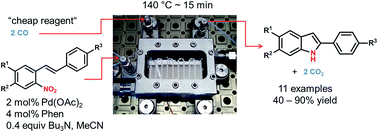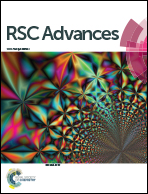Continuous flow synthesis of indoles by Pd-catalyzed deoxygenation of 2-nitrostilbenes with carbon monoxide†
Abstract
The palladium-catalyzed deoxygenation of o-vinylnitrobenzenes employing carbon monoxide as a terminal reductant produces indoles in a continuous flow environment. The reaction proceeds with catalyst loadings of 1 to 2 mol% Pd(OAc)2 in the presence of suitable ligands/additives and generates carbon dioxide as the only stoichiometric side-product. The reductive cyclization proceeds in a clean fashion with high initial reaction rates in the pressurized flow reactor, ultimately leading to deposition of catalytically inactive palladium(0) inside the channels of the flow device, allowing for an efficient catalyst recovery. A variety of o-vinylnitrobenzenes (o-nitrostilbenes and -styrenes) were converted to the corresponding indoles within 15 to 30 min at a reaction temperature of 140 °C to furnish products in good to excellent yields (10–20 bar CO pressure). Mechanistic aspects and the scope of the transformation are discussed.



 Please wait while we load your content...
Please wait while we load your content...